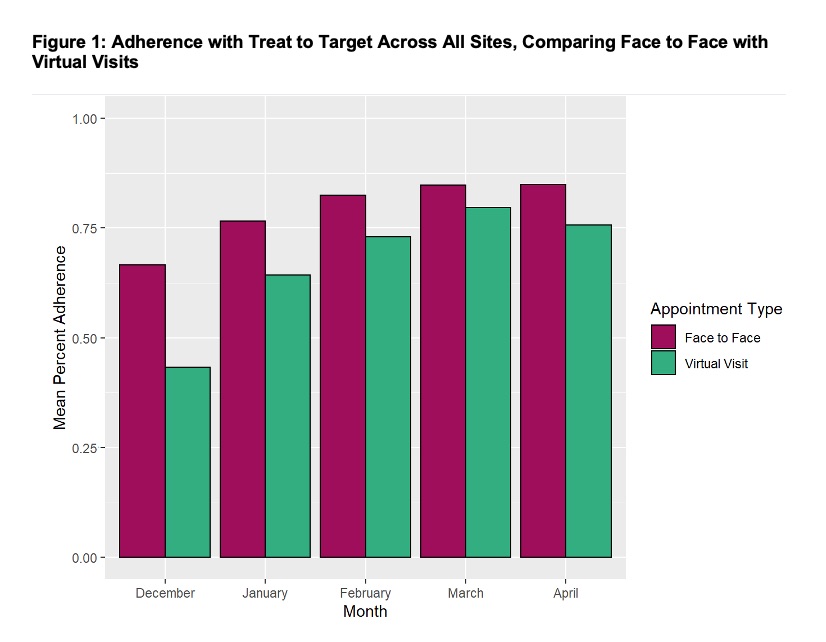Session Information
Session Type: Abstract Session
Session Time: 2:30PM-2:45PM
Background/Purpose: TTT is the recommended paradigm for managing RA according to major rheumatology organizations, however the literature suggests that TTT has not been widely implemented in US rheumatology. In a prior randomized controlled trial, we found that a learning collaborative (LC) was effective for improving implementation of TTT. (1) During the current study, we worked with US rheumatology practices on implementing TTT during 2020-2021 when some visits were conducted face-to-face (F2F) and other visits virtually (VV). These analyses examine differences in adherence with TTT based on whether the visit was F2F or VV.
Methods: During 2020-2021, we conducted a virtual Learning Collaborative (LC) for TTT in RA. 18 US-based rheumatology practices and 45 clinicians (MD, DO, NP, PA, RN) were engaged in the LC. The LC was 6 months in duration and each month the practices abstracted data from 20-25 visits with RA patients, focusing on adherence with TTT. Adherence was measured as a percentage of TTT component processes: 1) measure and document disease activity (any standard measure was acceptable), 2) determine a target disease activity, 3) make treatment changes if not at target, and 4) document shared decision-making. We then analyzed TTT adherence overall and by visit type, comparing F2F with VV. Further, VV visits were stratified as telephone or video.
Results: The 18 sites were distributed widely across the US, representing 10 states plus Washington DC, and their locations varied in COVID pandemic policies. During the 6 months, sites entered data on 1826 patient visits: 78% were F2F and 22% were VV. Overall adherence with TTT during the six months improved from a mean of 51% to 84%. Each component process of TTT was compared between F2F and VV visits (see Table 1). Over the full follow-up of the LC, there was greater adherence with TTT when visits were F2F (79% adherence) versus VV (65% adherence) (p < 0.0001). Documentation of a disease activity measure, a target, and change in treatment if not at target were all more common in the F2F versus VV visits (all p < 0.05). Documentation of shared decision making was similar across the two types of visits. F2F adherence started at 67% whereas VV was 43% (p < 0.0001). However, by the last month, F2F was at 85% and VV at 76% (p = 0.059) (see Figure 1). Of the VV, 43% were conducted by telephone and 57% by video. Comparing overall adherence with TTT across these two types of VVs, there was not difference in overall adherence between video visits and telephone visits, 64.8% and 65.3%, respectively.
Conclusion: Implementing TTT for RA is a challenge, especially during the COVID pandemic. Among 18 US rheumatology practices engaged in implementing TTT, we found that adherence with TTT was slightly worse for VV compared with F2F. However, adherence with TTT improved for both types of patient visits, even during the COVID19 pandemic, and was similar after a six-month learning collaborative.
1. Solomon, D. H., et al. Implementation of Treat-to-Target in Rheumatoid Arthritis Through a Learning Collaborative: Results of a Randomized Controlled Trial. Arthritis Rheumatol 2017;69:1374-1380.
To cite this abstract in AMA style:
Solomon D, Shadick N, Pincus T, Smolen J, Ellrodt J, Stratton J, Santacroce L, Katz J, Chatpar P, Stocks M, Mundell B, Downey C, Torralba K, White D, Baudek M, Szlembarski S, Barnhart S, Bilal J, Redford A, Lee D, Buchfuhrer J, Kramer H, Kwoh C, Villatoro-Villar M, Patnaik A, Guzman E, Trachtman R, Tesser J, Music D, Mickey L, Amin M, Potter J, Sundhar J, Sheingold J, Schmukler J, Horowitz D, Gulko H, Quinet R, Dhulipala S, Patel R, Keshavamurthy C, Carvajal Bedoya G, Dunn R, Kumar B, Lenert A, Zembrzuska H, Gebre M, Lenert P, Anandarjah A, Yang A, Grinnell-Merrick L, Goldsmith S, Zelie J, Wise L, Zagelbaum Ward N, Kaine J. Virtual Visits versus Face-to-Face Visits for Rheumatoid Arthritis (RA): Comparison of Treat to Target (TTT) Adherence in 18 US Rheumatology Practices [abstract]. Arthritis Rheumatol. 2021; 73 (suppl 9). https://acrabstracts.org/abstract/virtual-visits-versus-face-to-face-visits-for-rheumatoid-arthritis-ra-comparison-of-treat-to-target-ttt-adherence-in-18-us-rheumatology-practices/. Accessed .« Back to ACR Convergence 2021
ACR Meeting Abstracts - https://acrabstracts.org/abstract/virtual-visits-versus-face-to-face-visits-for-rheumatoid-arthritis-ra-comparison-of-treat-to-target-ttt-adherence-in-18-us-rheumatology-practices/


